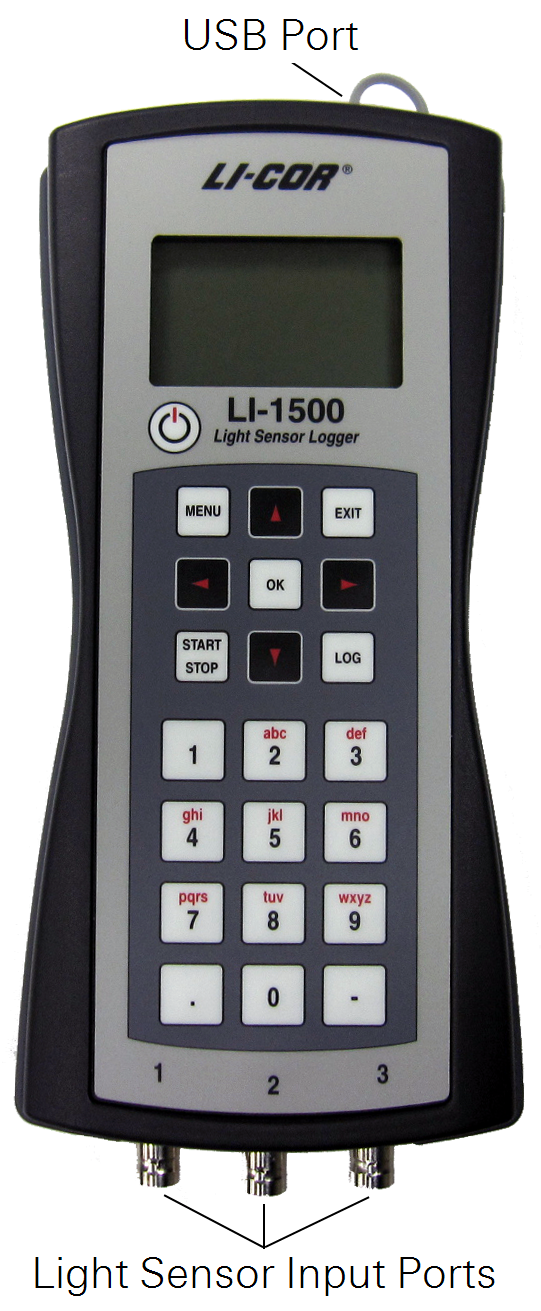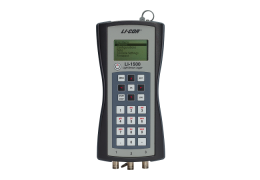Introduction to the LI-1500

The LI-1500 Light Sensor Logger is a 3-sensor logger that can also function as a handheld meter for displaying real-time data. Three BNC input ports accept LI-COR terrestrial and underwater light sensors.
With Standard Modes sampling, the LI-1500 collects samples at up to 20 Hz, from up to three sensors at once. Math operations and averaging can be applied to the data.
Raw Mode sampling collects samples at up to 500 Hz, from one sensor. Math operations and averaging are not available, but Raw Mode is useful for high frequency applications.
The optional Global Positioning System (GPS) can provide GPS data for viewing or logging.
The weather resistant console is constructed from ABS plastic with a rubber seal between the two halves. The rubber seal also serves as a shock cushion to protect the instrument from impact.
What's what
If you just received your LI-1500 Light Sensor Logger, check the packaging list to verify that you received everything that was ordered. Each LI-1500 should include the following items:
| Description | Qty. | Part # |
|---|---|---|
| LI-1500 Light Sensor Data Logger | 1 | - |
| Without GPS Antenna | - | 9915-003 |
| With GPS Antenna | - | 9915-004 |
| USB Mini B Dust Cover | 1 | 340-10566 |
| LI-1500 Accessory Kit | 1 | 9915-001 |
| 5P A/Mini-B USB Cable 6' | 1 | 392-07872 |
| AC-DC USB Power Supply 5V/1A | 1 | 591-19074 |
| USB Power Supply Prong Kit | 1 | 591-19075 |
| Carabiner Clip | 1 | 610-10456 |
| 1.5V Alkaline Size "AA" Batteries | 4 | 442-00854 |
| Multipurpose Screwdriver | 1 | 611-07902 |
Powering the LI-1500
The LI-1500 Light Sensor logger uses four "AA" size batteries. AC power (mains) may also be used, but "AA" batteries should be installed to prevent data loss in case AC power is interrupted during logging. An internal lithium cell battery maintains clock settings when "AA" batteries are depleted or absent. The lithium backup battery can last up to seven years. For replacement instructions, see Replacing the internal lithium battery. The AC power supply adapter will not charge the batteries.
Install batteries
Use a #1 Phillips screwdriver to remove the two screws that secure the battery cover on the back of the instrument. Push the rubber gasket aside to access hidden screw. Install four "AA" batteries. Observe proper polarity when installing batteries. Reattach the cover.

Low battery indicator
A "Low Battery" message appears along with an audible warning "beep" when the "AA" battery voltage drops to 4.0 V or below. The power will turn off when the voltage drops to 3.8 V. Battery voltage can be viewed in Monitor Mode (Monitor mode navigation).
AC power
The LI-1500 can be powered with AC (mains) power. Plug the AC to DC power supply adapter into a wall outlet supplying AC power. Plug the USB cable into the adapter. Plug the other end of the USB cable into the Mini USB port at the top end of the LI-1500. Batteries will not be charged by the USB power.

Cable connections
The mini USB port at the top end of the LI-1500 serves as the data transfer and power connection.
Data cable connection
The LI-1500 communicates with a computer through a USB cable connected to a mini USB port. The computer will identify the LI-1500 as a mass storage device named LI-1500.
Light sensor input ports

The three BNC bulkhead input ports at the bottom end of the LI-1500 are for connecting LI-COR light sensors with BNC terminations. The input ports are labeled 1, 2, and 3. They are identified as INPUT1, INPUT2, and INPUT3 in the user interface.
Memory
The LI-1500 is equipped with 1 GB of non-volatile flash memory. The instrument stores data on an internal Secure Digital (SD) card. The format for the SD card is FAT16. Do not modify the card in any way when connected to a computer, and never remove or replace the card unless it is with a card purchased from LI-COR (part number 616-10387). Table 1‑2 shows how many days it takes to fill the memory. When the memory is full, the device issues an error message: Routine Stopped: Out of Storage Space.
| Sampling Rate | Number of Days (Normal1) | Number of Days (Raw2) |
|---|---|---|
| 1 per hour | 12,500 | N/A |
| 1 per minute | 2083 | N/A |
| 1 per 10 seconds | 347.22 | N/A |
| 1 Hz (1 per second) | 34.72 | 253.13 |
| 2 Hz (2 per seconds) | 17.36 | 126.56 |
| 5 Hz (5 per second) | 6.94 | 50.62 |
| 10 Hz (10 per second) | 3.47 | 25.31 |
| 20 Hz (20 per second) | 1.74 | 12.65 |
| 500 Hz (500 per second) | N/A | 0.506 |
Precautions
The LI-1500 is weather resistant, but the following environmental limitations should be observed:
- If the LI-1500 is to be left outdoors and unattended for long periods of time, it should be installed in a protective enclosure or sheltered location. Install the protective plug in the USB port when the port is not in use.
- Exposure to direct sun decreases battery life and can cause battery leaks if the internal temperature exceeds the battery manufacturer's specifications. Cold temperatures can also significantly decrease battery life.
Maintenance
The LI-1500 is designed for low maintenance and generally requires little servicing beyond keeping it clean and replacing the batteries.
- Cleaning: The instrument display and keypad can be cleaned with a moistened non-abrasive cloth when necessary.
- Storage: When storing the LI-1500 for a long period of time, remove the "AA" batteries.
